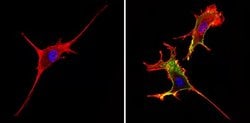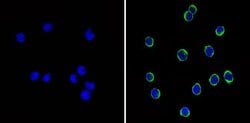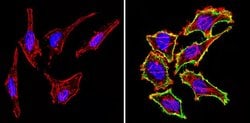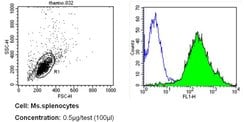Learn More
Invitrogen™ CD44 Monoclonal Antibody (1M7.8.1)
Rat Monoclonal Antibody
Supplier: Invitrogen™ MA4405
Description
MA4405 targets CD44 in FACS, IA, IF, IP, and WB applications and shows reactivity with mouse and Human samples. The MA4405 immunogen is mouse 80-95 kD lymphocyte surface glycoprotein H-CAM (CD44). MA4405 detects a standard 85-kDa isoform of CD44 and a number of high molecular mass variant isoforms. This antibody is produced by injecting Rat IgG secreting hybridoma cells into the peritoneum of mice. The resulting ascites is collected from the mice and the antibody is purified. This product is a Low Endotoxin formulation. This product has been tested for endotoxins by limulus amoebocyte lysate (LAL) assay and contains an endotoxin concentration of less than or equal to 10 endotoxin units per milligram (EU/mg).
CD44 cell surface antigen is a 100 kDa type 1 transmembrane glycoprotein widely expressed on human leucocytes, white matter of the brain and by some epithelial cells of the intestine and breast. Several isoforms of CD44 exist, including the predominant CD44H isoform detected in many normal tissues. CD44 is a receptor for hyaluronic acid (HA) and is involved in cell-cell interactions, cell adhesion and migration. CD44 also participates in a wide variety of cellular functions including lymphocyte activation, recirculation and homing. CD44 expression may be up-regulated upon some carcinomas, and it has been speculated that this may be related to metastatic potential. CD44 is expressed by hematopoietic, non-hematopoietic cells, epithelial tissues, and to filopodia in cultured keratinocytes. Further, bone marrow myeloid cells and memory T cells express CD44 at high levels, and peripheral B and T cells can upregulate the expression of CD44 in response to certain stimulatory events. Transcripts for the CD44 gene undergo complex alternative splicing that results in many functionally distinct isoforms, however, the full-length nature of some of these variants have not been determined. Alternative splicing is the basis for the structural and functional diversity of the CD44 protein. Diseases associated with CD44 dysfunction include superficial keratitis and lichen sclerosus. CD44 also may be related to tumor metastasis formation.
Specifications
| CD44 | |
| Monoclonal | |
| 1 mg/mL | |
| PBS with no preservative | |
| P15379, P16070 | |
| CD44 | |
| Mouse 80-95 kD lymphocyte surface glycoprotein H-CAM (CD44). | |
| 500 μg | |
| Primary | |
| Human, Mouse | |
| Antibody | |
| IgG2b |
| Flow Cytometry, Inhibition Assays, Immunoprecipitation, Western Blot, Immunocytochemistry | |
| 1M7.8.1 | |
| Unconjugated | |
| CD44 | |
| AU023126; AW121933; AW146109; Bovine CD44; CD44; CD44 antigen; CD44 antigen-like protein; CD44 molecule; CD44 molecule (Indian blood group); CD44 protein; CD44 variant; CD44A; CD44-like protein; CDW44; cell surface glycoprotein CD44; Cell surface glycoprotein CD44 (hyaluronate binding protein); cell-surface glycoprotein; chondroitin sulfate proteoglycan 8; CSPG8; ECMRIII; ECMR-III; Epican; extracellular matrix receptor III; extracellular matrix receptor-III; GP90 lymphocyte homing/adhesion receptor; HCELL; hematopoietic cell E- and L-selectin ligand; heparan sulfate proteoglycan; HERMES; Hermes antigen; homing function and Indian blood group system; HUTCH-I; hyaluronan receptor; Hyaluronate receptor; IN; LHR; Ly-24; lymphocyte antigen 24; lymphocyte surface antigen precursor CD44; MC56; MDU2; MDU3; METAA; MIC4; PGP I; Pgp1; PGP-1; PGPI; PGP-I; Phagocytic glycoprotein 1; phagocytic glycoprotein I; putative Bos taurus CD44; RHAMM; sCD 44; sCD44; soluble CD 44; soluble CD44 | |
| Rat | |
| Protein G | |
| RUO | |
| 12505, 960 | |
| -20°C | |
| Liquid |
Your input is important to us. Please complete this form to provide feedback related to the content on this product.





